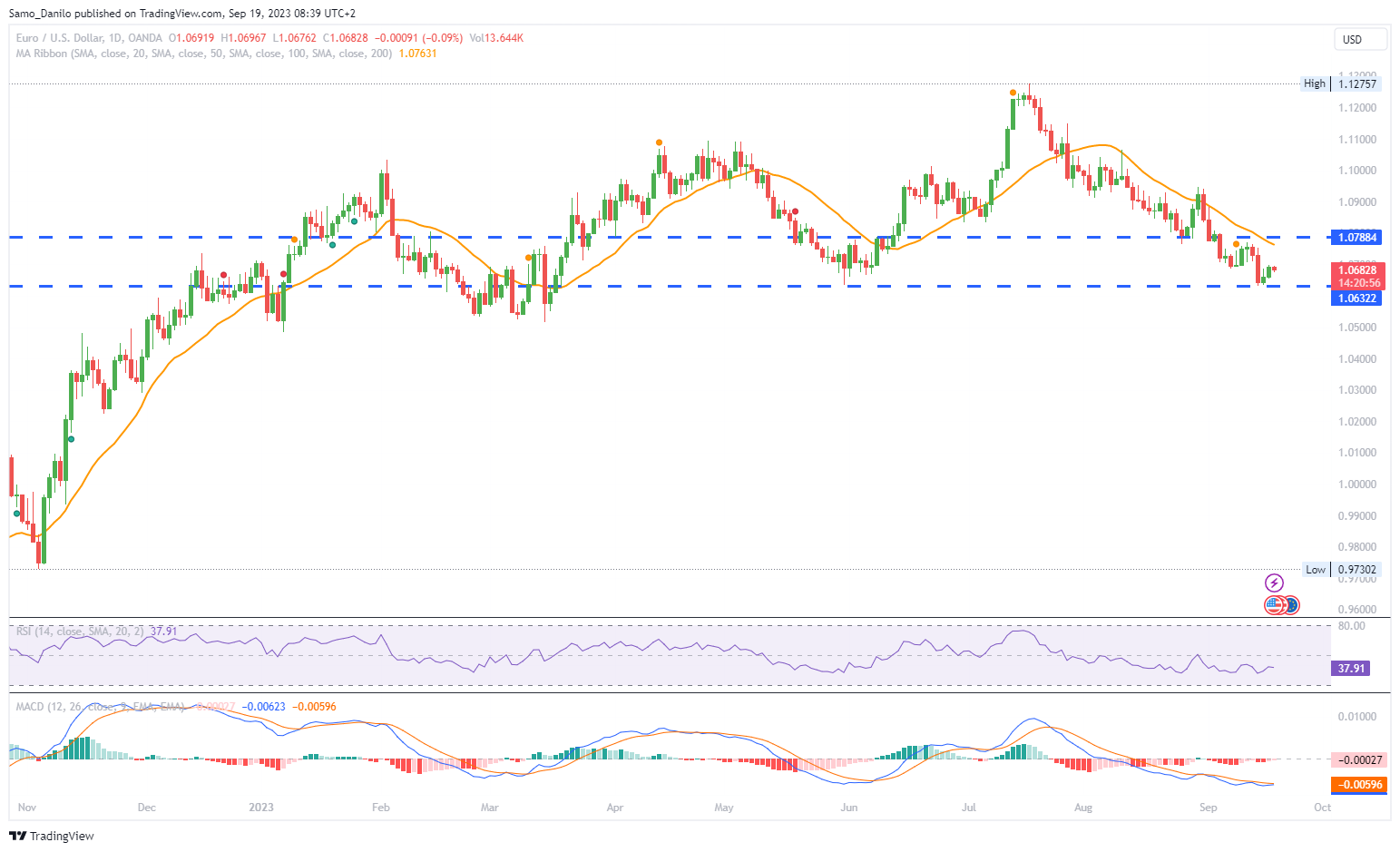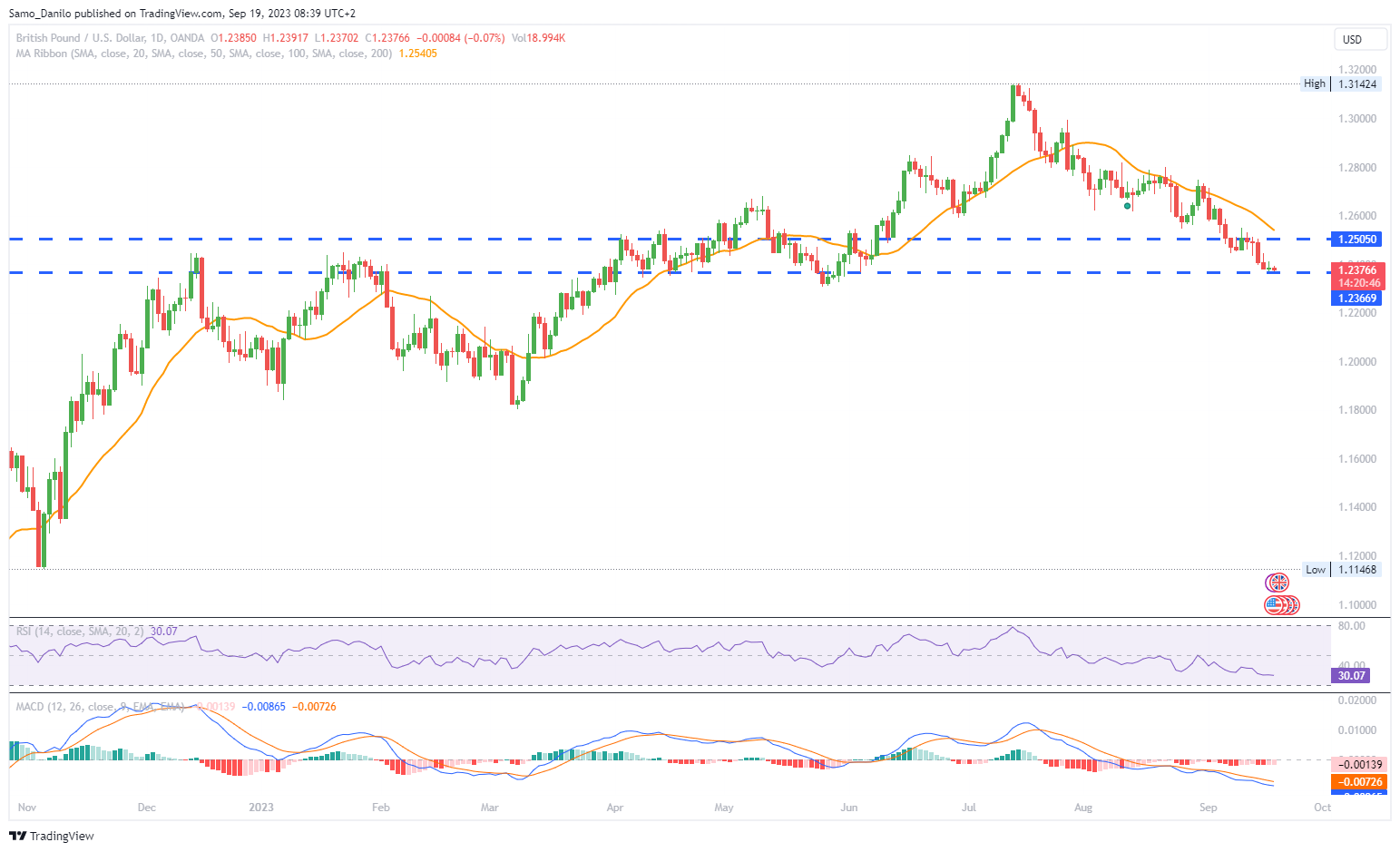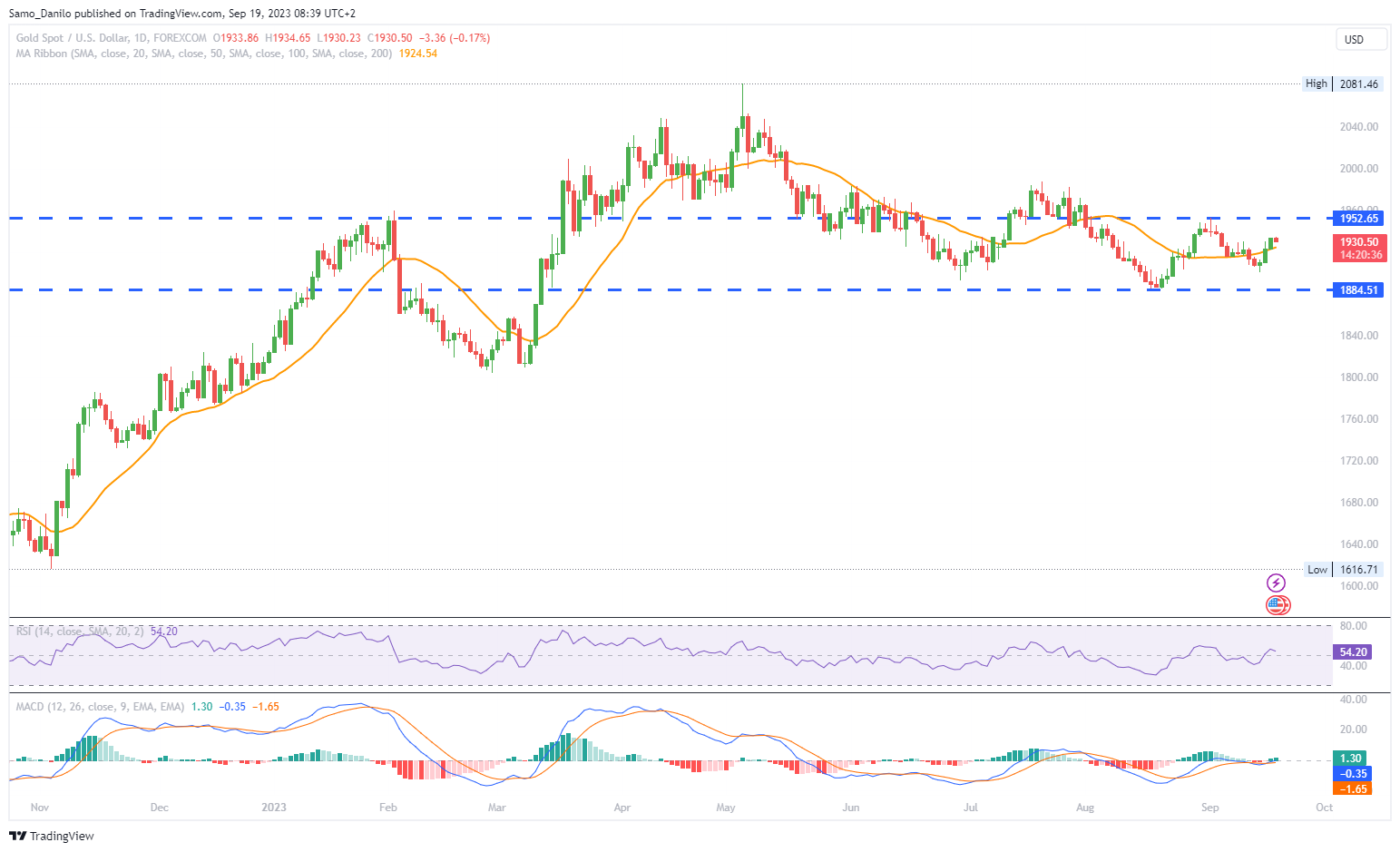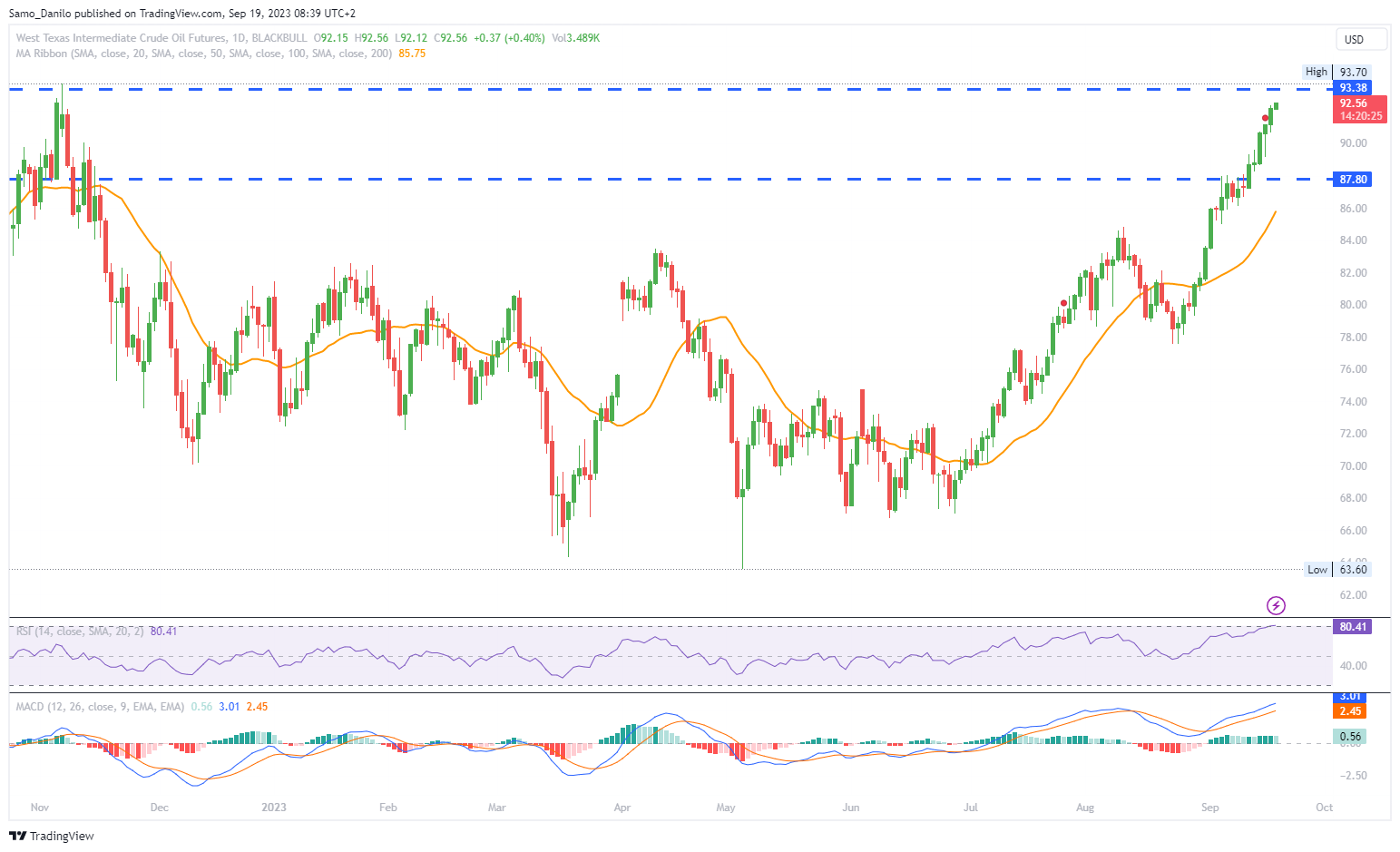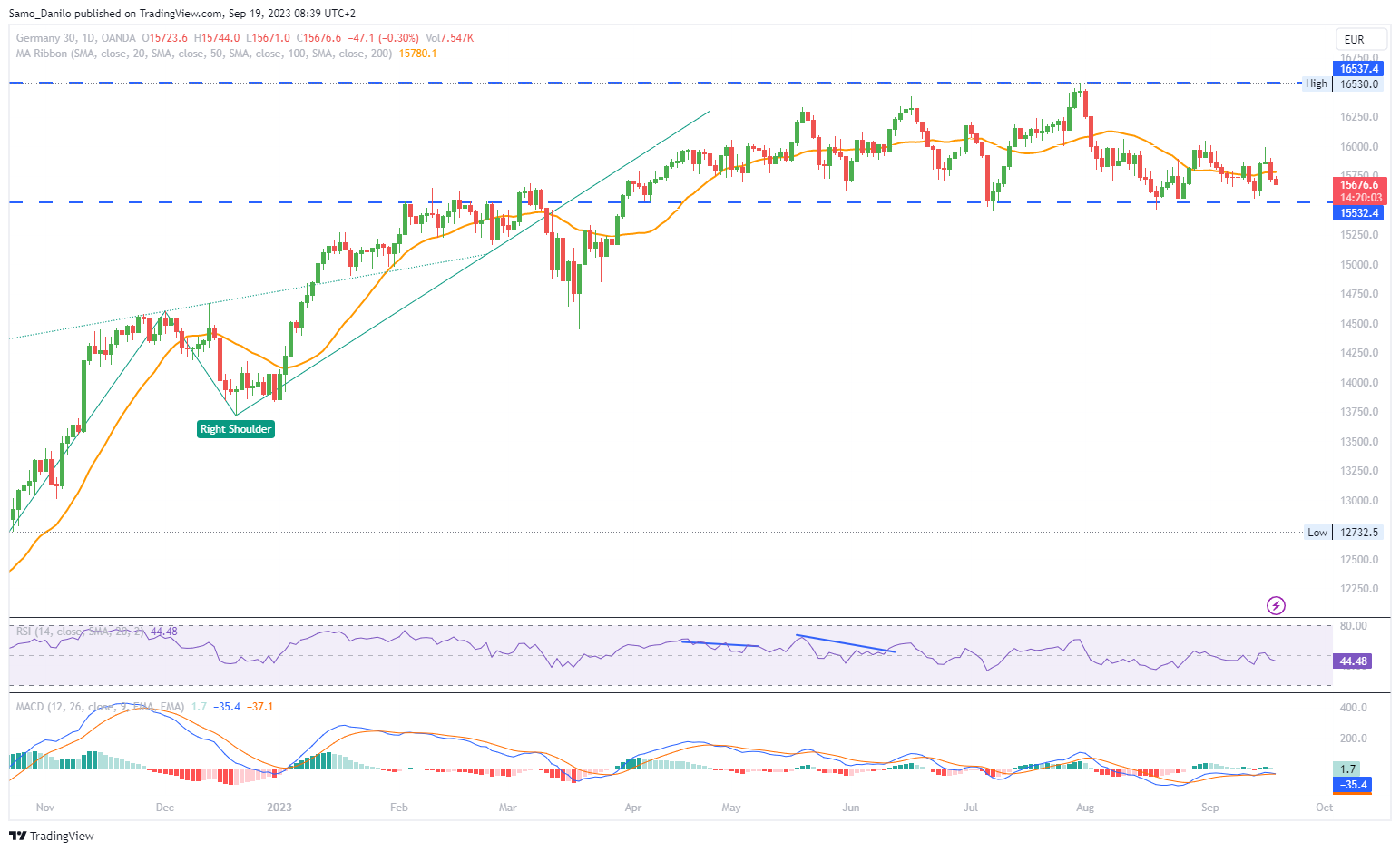EURUSD
- EUR/USD has broken its two-day winning streak and is trading lower, hovering around 1.0680 during the Asian session on Tuesday. This decline reflects market caution ahead of the upcoming policy decision by the US Federal Reserve (Fed).
- Investors are keeping a close eye on the release of the Harmonized Index of Consumer Prices (HICP) and Core HICP data from the Eurozone. These datasets are expected to provide further insights into the economic situation within the Eurozone.
- The market sentiment now leans toward the European Central Bank (ECB) not raising interest rates further. Instead, the focus has shifted to how long rates will remain at their current levels. This shift in expectations can influence the dynamics of the EUR/USD pair.
- Similar to the ECB, the Federal Reserve is also not expected to make any changes in interest rates. Instead, the market's attention will be directed towards the Fed's statement, economic projections, and comments made by Fed Chair Jerome Powell. Any hints about the future direction of US monetary policy can significantly affect the EUR/USD pair.
- In the United States, Housing Starts and Building Permits data is scheduled for release. These figures will be closely watched by investors for insights into the health of the US housing market, which can impact the overall economic outlook and currency movements.
Closing statement: EUR/USD has experienced a downturn as the market adopts a cautious stance ahead of both the Fed and ECB policy decisions. Economic data from the Eurozone and the US housing market will be pivotal in determining the pair's direction in the near term. Additionally, the market will closely analyse the statements and comments from central bank officials for hints about future monetary policy actions.
GBPUSD
- The GBP/USD pair continues to face significant challenges in gaining substantial momentum and is trading near its lowest level since early June, a level touched on Monday.
- Investors appear to be adopting a cautious stance, particularly in light of the key macroeconomic events scheduled for this week. This caution could limit GBP/USD's ability to establish a clear trend in the short term.
- Last week, the relentless strength of the US Dollar (USD) exerted consistent downward pressure on GBP/USD. The performance of the USD is a crucial factor influencing the currency pair's movements.
- Wednesday will see the release of the UK's Consumer Price Index (CPI) data, which precedes the Bank of England's (BoE) monetary policy announcements scheduled for Thursday. These events are likely to be pivotal in determining the direction of GBP/USD.
- Results from the BoE's quarterly survey indicate that 40% of the UK public believe it would be best for the economy if interest rates were lowered. This figure is the highest since 2008. Additionally, medium-term inflation expectations have eased slightly from 3% to 2.9%, as per the survey.
| SMA (20) | Falling |
|
|
| RSI (14) | Slightly Falling |
| |
| MACD (12, 26, 9) | Slightly Falling |
|
Closing statement: GBP/USD remains under pressure, with investors displaying caution as they await critical economic data releases and the BoE's monetary policy decisions. The strength of the US Dollar and shifting public sentiment regarding interest rates and inflation expectations in the UK are factors to watch as they can impact the pair's movements in the coming days.
GOLD
- Gold price has recently exhibited a bullish reversal, closing above the critical 50-Daily Moving Average (DMA) at $1,932. This suggests a shift in sentiment from bearish to bullish.
- Gold price experienced a notable rally, extending its rebound from three-week lows at $1,901. This recovery was partly fueled by a retracement in the US Dollar, which had reached six-month highs against various currencies. Declining US Treasury bond yields also contributed to this retracement.
- Expectations of a dovish stance from the Federal Reserve (Fed) have been growing. This sentiment is linked to the tightening cycles nearing their end for major global central banks like the European Central Bank (ECB) and the Bank of England (BoE).
- Several factors are supporting gold prices, including profit-taking in the US Dollar ahead of the Fed decision, rising oil prices, and increased physical gold premiums in China.
- Gold price may react to the release of US Housing Starts and Building Permits data later in the day. This data assumes importance, especially after homebuilder sentiment turned negative for the first time in seven months.
| SMA (20) | Slightly Rising |
|
|
| RSI (14) | Slightly Rising |
|
|
| MACD (12, 26, 9) | Slightly Rising |
|
Closing statement: Gold has experienced a bullish reversal, supported by a pullback in the US Dollar, declining bond yields, and expectations of a dovish Fed. The upcoming US housing data could provide further cues for the precious metal's price movement.
CRUDE OIL
- Western Texas Intermediate (WTI), the US crude oil benchmark, is trading around $91.70. It has been gaining momentum due to a tightening supply outlook driven by Saudi Arabia and Russia.
- Saudi Arabia's Energy Minister, Prince Abdulaziz bin Salman, emphasized the efforts of the Organization of Petroleum Exporting Countries and its allies (OPEC+) to stabilize oil markets and enhance global energy security. Notably, there is no specific target price level for crude mentioned; instead, the focus is on market stability.
- Despite the supply efforts, there are concerns and uncertainties in the oil market. Prince Abdulaziz mentioned uncertainties related to Chinese demand, European economic growth, and central bank actions to combat inflation. These factors can influence oil prices.
- The CEO of Aramco, a major oil company, has reduced the long-term demand forecast for oil. The new projection estimates global demand to reach 110 million barrels per day (bpd) by 2030, down from the previous estimate of 125 million bpd.
- The American Petroleum Institute (API) and the International Energy Agency (IEA) are set to release Crude Oil Stock data for the week ending September 15. This data can provide insights into supply and demand dynamics.
| SMA (20) | Rising |
|
| |
| RSI (14) | Rising |
|
|
|
| MACD (12, 26, 9) | Rising |
|
|
Closing statement: WTI oil prices are on the rise, supported by supply constraints and OPEC+ efforts to stabilize the market. However, uncertainties and concerns, along with lowered long-term demand forecasts, highlight the complexity of the oil market. Upcoming data releases will be closely monitored for further market insights.
DAX
- The DAX, a key German stock market index, experienced a decline of 1.05% in its value. This retracement reversed the 0.56% gain recorded in the previous session, with the index settling at 15,727 on Monday.
- The DAX and broader European equity markets were influenced by hawkish commentary from the European Central Bank (ECB). Although there were hints of the ECB potentially slowing down after the rate hike last Thursday, investors remained sensitive to ECB-related discussions.
- Peter Kazimir, the Governor of the National Bank of Slovakia, garnered attention with remarks suggesting that the ECB might require until March to assess whether additional rate hikes are necessary. This implies ongoing uncertainty about the direction of monetary policy.
- Luis de Guindos, an Executive Board member of the ECB, failed to provide support to the DAX. He mentioned that "underlying inflation’s worst moment has passed and it should moderate." This suggests a more optimistic view of inflation.
- Finalized inflation figures for August in the Eurozone will be closely watched. Given the market's sensitivity to hawkish ECB commentary, any upward revisions to core inflation could exert pressure on the DAX.
| SMA (20) | Neutral | |
| RSI (14) | Slightly Falling |
|
| MACD (12, 26, 9) | Neutral |
Closing statement: The DAX faced a downturn driven by hawkish ECB commentary and uncertainty about future rate hikes. The index remains sensitive to central bank communications and economic data, particularly inflation figures, which can influence investor sentiment.
